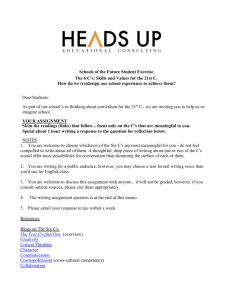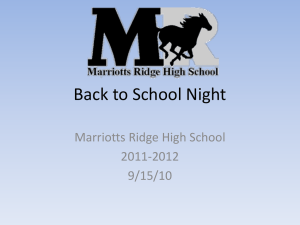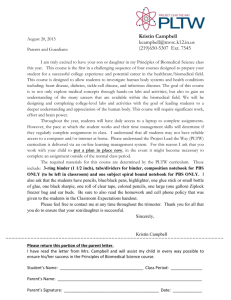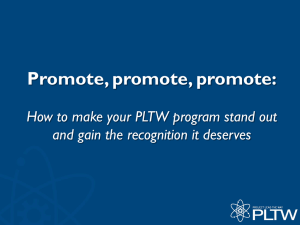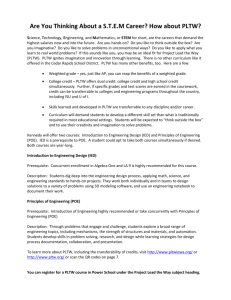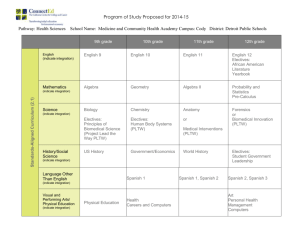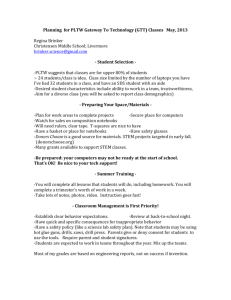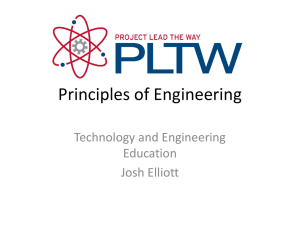Rigor & Relevance (PowerPoint)
advertisement
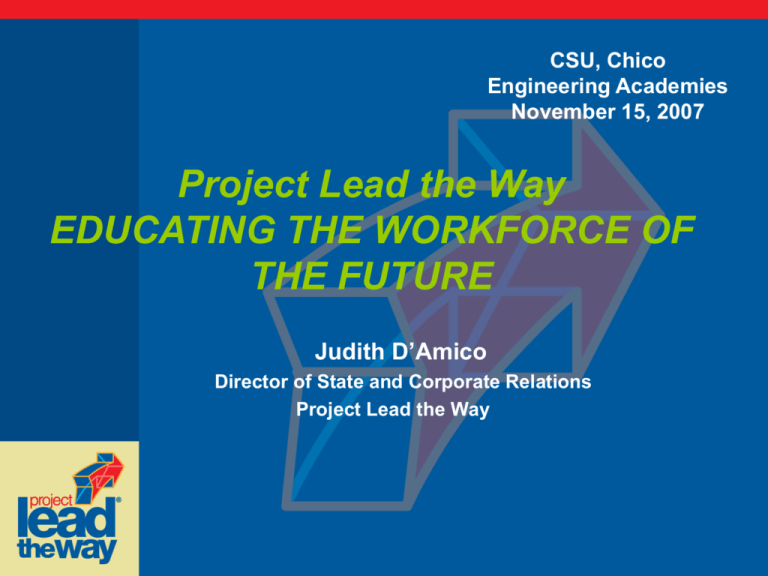
CSU, Chico Engineering Academies November 15, 2007 Project Lead the Way EDUCATING THE WORKFORCE OF THE FUTURE Judith D’Amico Director of State and Corporate Relations Project Lead the Way THE RELEVANCE QUESTION RELEVANT TO STUDENTS RELEVANT TO TEACHERS RELEVANT TO PARENTS RELEVANT TO BUSINESS RELEVANT TO COMMUNITY Reaching all Students (80 % HS) What does High Rigor & High Relevance look like in a school curriculum ? Project Lead The Way is a model. Evaluation 6 Synthesis 5 Analysis 4 Application 3 Understanding 2 Awareness 1 Bloom’s Levels of Learning High Rigor High Context High Rigor Low Context Low Rigor High Context Low Rigor Low Context 1 2 3 4 5 Knowledge Apply in discipline Apply across disciplines Apply to Apply to predictable unpredictable real-world situations real-world situations Application Model Adapted from W. Daggett This is Project/Problem Based Learning! From: Principles of Engineering Design and build a modifiable device that will launch a ping pong ball into a 10 inch bowl with 100% accuracy. On launch day the distance will be varied by the instructor within a range of 5 to 15 feet. High Rigor, High Context with Predictable Outcome Evaluation 6 Synthesis 5 Analysis 4 Application 3 Understanding 2 Awareness 1 Bloom’s Levels of Learning High Rigor High Context High Rigor Low Context Low Rigor High Context Low Rigor Low Context 1 2 3 4 5 Knowledge Apply in discipline Apply across disciplines Apply to Apply to predictable unpredictable real-world situations real-world situations Application Model Adapted from W. Daggett This is Project/Problem Based Learning! From: Digital Electronics Design and build an electronic device to automatically measure the distance a person is away from the device. High Rigor, High Context with Unpredictable Results Evaluation 6 Synthesis 5 Analysis 4 Application 3 Understanding 2 Awareness 1 Bloom’s Levels of Learning High Rigor High Context High Rigor Low Context Low Rigor High Context Low Rigor Low Context 1 2 3 4 5 Knowledge Apply in discipline Apply across disciplines Apply to Apply to predictable unpredictable real-world situations real-world situations Application Model Adapted from W. Daggett STUDENT COMMENTS PLTW is a better learning experience because you are self-motivated. The learning that comes when it doesn’t work is just as valuable as the learning when it does work. You think differently because you cannot just look up the answers. You have to come up with the solution. It is more critical thinking. Though I’m not pursuing an engineering degree, the problem-solving skills learned are important no matter your field. Teacher & Principal Comments: Our teachers recognize that the same skills emphasized in PLTW classes make a student successful in any class. (Diane Lashinsky, Administrator, The Innovation School) I am excited to see PLTW courses challenging students with good problems that require strong math, science, and analytical skills. As an engineer teaching these kinds of things to high school kids is as good as it gets. (Craig Devine, PLTW Teacher & Former Engineer.) Business Comments: I hired four PLTW students right out of high school. They came to us with real-life job skills and their work has been used in successful proposals, products, and systems installations. This program is a win for everyone involved. (Andrea L. Mann, Ph.D. President, Mann Wireless, Ltd.) Business Comments: We are an electronics manufacturing facility, so the idea of PLTW fits well into what we do. It is exciting to us that our local school has embraced the technology field, and that local students can finally look at us, know what we do, and want to be part of it. (Peg Murphy, Director HR, Espey Mfg. & Electronics Corporation) BUSINESS & INDUSTRY SUPPORT CMTA (California Manufacturers & Technology Association AeA (American Electronics Association Intel Comcast APPA (American Public Power Association IBM Northrup Grumman Qualcomm Gencorp/Aerojet PLTW’s NEW BIOMEDICAL SCIENCES CURRICULUM: Critical Component of the 21st Century Workforce 14 PLTW™ Biomedical Sciences Program Design is based on the successful PLTW Engineering Program to: Address the impending critical shortage of qualified biomedical science and health professionals. Prepare students for rigorous post-secondary education and training. Biomedical Careers --- some examples --Doctor Nurse Dentist Veterinarian Medical Technologist Pharmaceutical Scientist Biomedical Engineer Social worker Health Information Manager Pharmacist Ultrasound Technician Medical Technical Writer Radiologist Biomedical Sciences High School Courses Principles of the Biomedical Sciences Student work involves the study of human medicine, research processes and an introduction to bio-informatics Human Body Systems This course will engage students in the study of basic human physiology, especially in relationship to human health. Use LabVIEW software and Vernier probes to measure EKG, heart rate, and blood pressure Medical Interventions Students will investigate various medical interventions that extend and improve quality of life, including gene therapy, pharmacology, surgery, prosthetics, rehabilitation, and supportive care Science Research This capstone course gives student teams the opportunity to work with a mentor, identify a science research topic, conduct research, write a scientific paper, and defend team conclusions and recommendations to a panel of outside reviewers 17 Key Biological Concepts: Cellular basis of life Homeostasis Metabolism Inheritance of traits Defense against disease Key Engineering Concepts: Process of design Feedback loops Fluid dynamics Relationship of structure to function Systems Next Curriculum Area of Focus CREATION OF NEW COURSEWORK FOCUSED ON ENERGY AND POWER FOR BOTH MIDDLE SCHOOL AND HIGH SCHOOL PLTW CURRICULUM. Energy & Power: A Course for PLTW High Schools and Middle Schools A full year course will be developed in Energy and Power for high schools and a 9 week unit of study for middle schools. The course will contain at least the following content: Fossil Fuels Bio Fuels Solar Energy Nuclear Energy Geothermal Energy Power Systems Energy and Power Conversion Systems Experts from industry and higher education will be engaged to identify the key learning concepts as well as project/problem themes intended to show that students have learned the key learning concepts. National Recognition National Academy of Engineering, National Academy of Science and the Institute of Medicine October 2005 PLTW program is recommended as the model curriculum for creating “K-12 rigorous curricula, standards and assessments based on world-class standards.” “Students participating in PLTW courses are better prepared for college engineering programs.” 22 Innovative Technical Activity in Academics Project Lead The Way, Inc. and San Diego State University Education Program of the Year -2007 Project Lead The Way 2006 Manhattan Institute Social Entrepreneurship Award Project Lead The Way 2006 Bayer Science Foundation K-12 STEM Best Practices Award Received endorsement of the American Aerospace Industry Association (AIA) in December, 2006 as offering “proven curriculum and teacher professional development” with “the potential to increase the quantity and quality of engineers and engineering technologists graduating from our education system.” Visit our Website for more Information WWW.PLTW.ORG Judith D’Amico, Director State and Corporate Relations Western Region judithdamico@comcast.net
